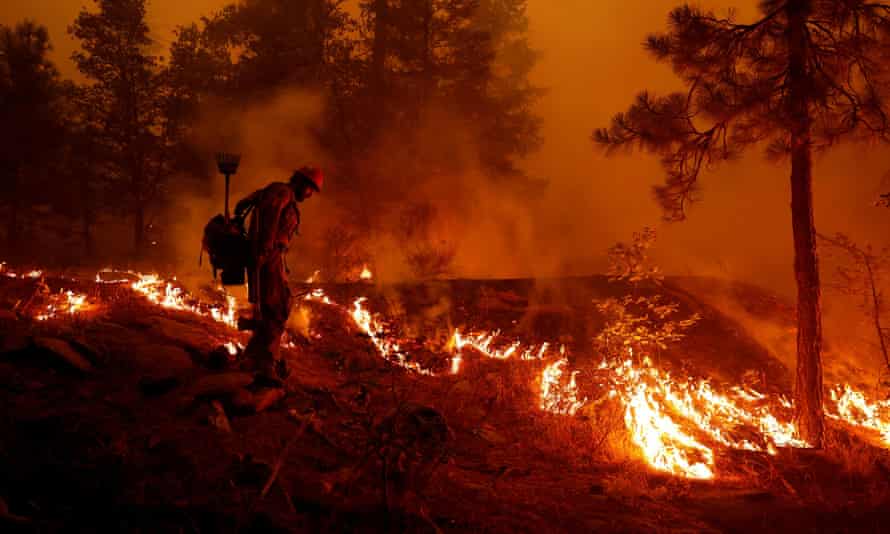Extract from The Guardian
Climate crisis in the American west
Judge demands information from PG&E utility as investigators seek cause of blaze spanning 679 sq miles.

The US Forest Service firefighter Ben Foley lights backfires to slow the spread of the Dixie fire near the town of Greenville, California, on Friday.
First published on Sun 8 Aug 2021 00.43 AEST
At least eight people were missing on Saturday as a fire continued to scorch through northern California communities, forest and tinder-dry scrub in the Sierra Nevada mountains.
People in the scenic region were already facing a weekend of fear as the huge Dixie fire threatened to reduce thousands of homes to ashes.
The blaze, which has been raging for three weeks and incinerated much of the gold rush-era town of Greenville this week was threatening more than 10,000 buildings in the northern Sierra Nevada. It had engulfed an area larger than New York City.
“We have received reports of eight unaccounted-for individuals,” the Pulmas county sheriff’s office, about 160 miles north of Sacramento, said on Saturday afternoon, asking for the public’s help in finding them.
Five of the missing belong to Greenville.
Dixie was the largest current wild-land blaze in the nation and the third-largest in recorded California history, according to the state department of fire and forestry protection.
The fire was less than a quarter contained on Saturday early afternoon, said Edwin Zuniga, a firefighter and spokesman for Cal Fire, the combined firefighting agencies battling the blaze.
“We’re hoping to gain ground. There are favorable weather conditions, with less wind and a blanket of smoke that blocks direct sunlight. It allows a higher humidity, which helps us,” he said.
Meanwhile, a federal judge has ordered the California utility Pacific Gas & Electric to “explain its role” in the Dixie fire’s combustion, according to a number of news reports on Saturday.
Investigators are still trying to pinpoint the cause of the fire. On Friday, the US district judge William Alsup issued an order demanding information from PG&E on a tree that fell on a power line at the point of ignition.
Wind-driven flames destroyed dozens of homes and most of Greenville’s downtown on Wednesday and Thursday, and also heavily damaged Canyondam, a hamlet with a population of about three dozen people. The fire reached Chester but crews managed to protect homes and businesses there, officials said.
Charlene Mays kept her gas station in Chester open as long as she could, telling weary firefighters not to apologize for the trail of ash their boots left on the floor. But when the small town on the north-west shore of Lake Almanor lost power two days ago, Mays decided it was time for her to leave.
She ran home to grab a box of valuables. The smoke was so thick it was hard to breathe. Chunks of ash broke apart as they hit the ground, making a sound like broken glass.
Since then, Mays has been living in the parking lot of Lassen College in Susanville. Her husband stayed behind to maintain some water tanks firefighters were using. It’s just her, a miniature pinscher chihuahua named Jedidiah and a pit bull named Bear.
Her home was still standing on Friday but her fate was bound with the direction of the wind and she wasn’t alone.

“I’ve got probably 30 of my regular customers right here,” she said.
The Dixie fire, named for the road where it started, now spans an area of 679 square miles. No injuries or deaths had been reported by early Saturday.
Weather at the fire site was expected to have higher humidity and calmer winds on Saturday with temperatures topping 90 degrees Fahrenheit instead of the 40-mph gusts and triple-digit highs recorded earlier in the week.
Heatwaves and historic drought tied to the climate crisis have made wildfires harder to fight in the American west.

The burned-out remains of a gas station along Main Street in downtown Greenville. Photograph: Peter DaSilva/UPI/REX/Shutterstock
Scientists say climate breakdown has made the region much warmer and drier in the past 30 years and will continue to make weather more extreme and wildfires more frequent and destructive.
Air quality advisories extended through the San Joaquin Valley and as far west as the San Francisco Bay Area, where residents were urged to keep their windows and doors shut.
California is on track to surpass last year, which had the worst fire season in recent recorded state history.
Since the start of the year, more than 6,000 blazes have destroyed more than 1,260 sq miles, more than triple the losses for the same period in 2020, according to state fire figures.
The Dixie fire ignited less than 10 miles from the start of the 2018 Camp Fire, the deadliest in California’s history, also sparked by PG&E equipment, in the thickly forested Feather River Canyon, 100 miles north of state capital Sacramento. The Camp fire destroyed the towns of Paradise and Concow and killed 85 people.
California’s raging wildfires were among more than 100 large, active fires burning across 14 states, mostly in the west where historic drought conditions have left lands parched and ripe for ignition.
No comments:
Post a Comment